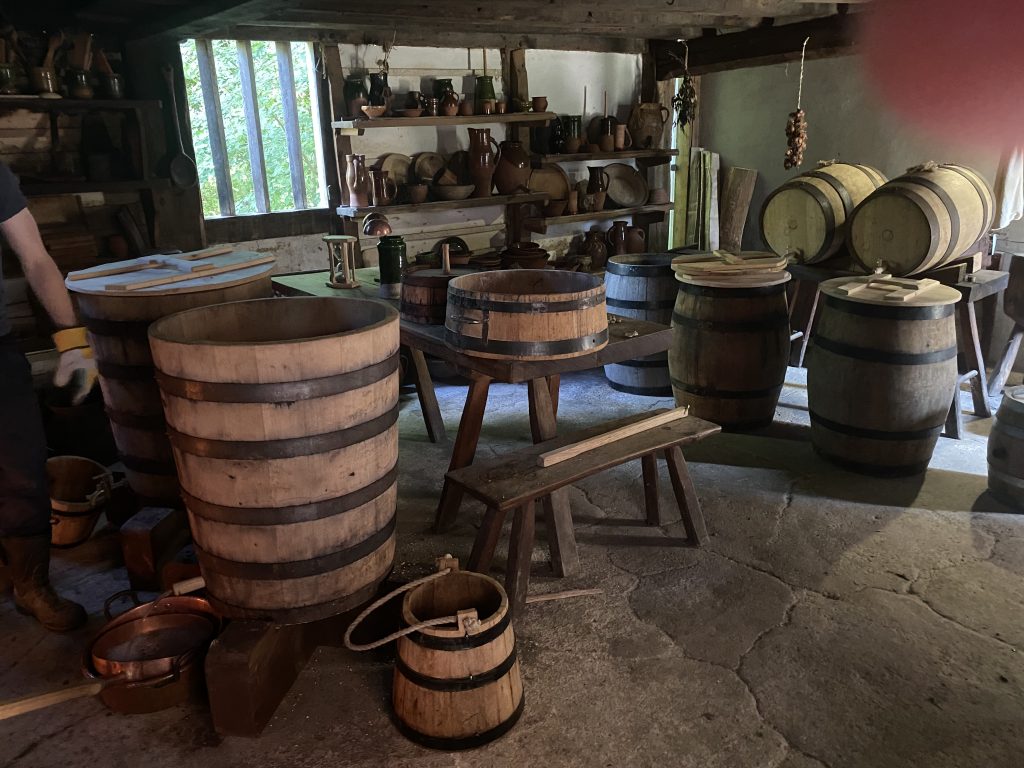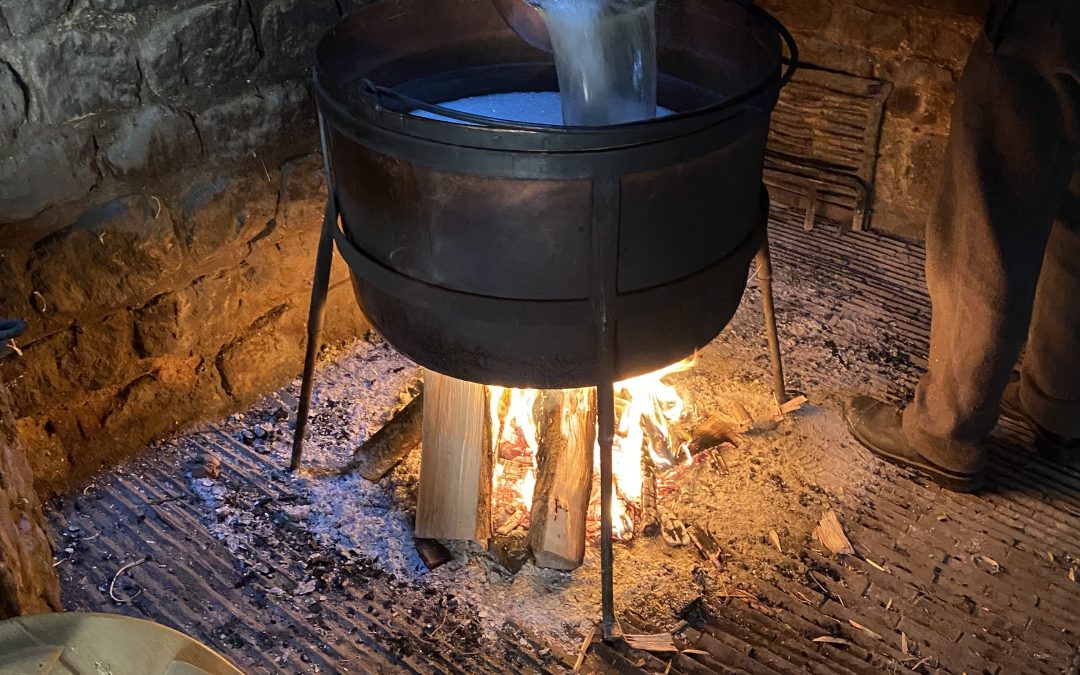Contributing to History
Britain’s oldest and most original Maltings, not surprisingly, attracts both historians and projects seeking to understand and/or re-create history. A current research project in which we have been invited to participate is the re-creation of an authentic Tudor Beer.

The Amazingly Authentic Tudor Brewery, Mash Tun to the left, Fermenting Vessels to the right.
Next, it is all about the ingredients – barley malt (our contribution), water, yeast and hops. For the barley, a very ancient variety called Bere, was chosen. Bere, variously put at 1,000 years old, possibly 6,000 years old, is still grown on the ‘whisky coast’ of west Scotland, on the Isle of Islay, so was almost certainly around in the Tudor period. A small parcel of Bere barley was dispatched to us at Warminster to be made into brewing malt.
Our very traditional method of malting is as authentic as it can be – we know this thanks to the dialogue we have with the archaeologists excavating up to four 1200-year-old Anglo-Saxon malthouses on a single site at Sedgeford, Nr King’s Lynn, Norfolk.
At Sedgeford there is clear evidence of an in-line process comprising a steeping trough adjacent to a clay (tiled) germination floor, and then a (wood fired) kiln, in that order. Just like us at Warminster (1855), and therefore almost certainly the same in the Tudor period (1485-1603).

Ladling the ‘Brewers Wash’ into the Copper (approx.1 gallon at a time).
We delivered the Bere malt to Singleton on Friday 3rd September so that the Tudor brewing team could start working over the weekend. I was invited to visit the following Monday (6th).
The brewery is housed in the Winkhurst Tudor Kitchen, set at the western end of the park, and I was met by Marc Meltonville, a notable food and drinks historian (on both sides of the Atlantic) who is the project manager at this stage. I arrived as they were (effectively) ‘sparjing the grist’ – after ‘mashing in’, running a second volume of hot water through the brewers grist. This particular grist was 50% Bere barley malt and 50% Oat malt, also supplied by Warminster Maltings.
The team were very happy with the extraction of the “brewers wash”, as it is referred to, a clear and distinctly flavoursome liquid. I did venture a taste, and I was able to determine that with the addition of hops, in the copper (kettle), followed by yeast in the fermenting vessels, there was definitely potential for something interesting.
Although the yield of “brewers wash” was satisfactory, as far as Marc was concerned, he was not entirely happy with the “brewers grist”. He felt that their grinding procedure through “the quern” was producing too much flour. I pointed out that our standard milling process at the Maltings produces a ‘20/70/10 grist’: 20% husk; 70% grits; 10% flour. With a little adjustment to “the quern” we appeared to achieve something a lot closer to the 20/70/10 standard!
Not surprisingly, I questioned what was the objective of this research. The answer: to try and discover “the diet of the Irish people before the arrival of, and ultimate dependence on, the potato in the 17th century”. I was told that much of what we know about the food and drink of our earliest ancestors is purely from the written word. It is all very well documented, but there is not very much practical evidence or experience of whether the chronicles are accurate records. The only way to find out, of course, is to actually try and replicate that which is recorded, and to sample the produce. And that is what the Tudor Beer is all about.
After the research chemists have received all their samples, there should be in the order of 160 gallons of beer left over. I have put Marc in touch with a local brewer to see whether this can be bottled. This will only happen if the beer is good to drink. But the beer can never be sold, because it will not/cannot completely comply with modern food standards. But, if I should get to sample it, I will let you know!

FoodCult is funded by the European Research Council and it is hosted by Trinity College Dublin. The Principal investigator is Susan Flavin. foodcult.eu

Adrian hand milling the malt with “the quern”.
Harvest Review
The cool, often wet, weather, that was a tedious feature that seemed to prevail through June, July and into early August, delayed the ripening of the barley crops, but it certainly did not impair the quality. So we have barns full of top quality malting barley to meet our requirements for the next 12/18 months.
Maris Otter barley, completing it’s 56th harvest, again demonstrated what a resilient variety of barley it is. The freezing cold April, and lack of sun in both June and July, did nothing to help this barley’s full potential, but it still managed to deliver, producing fine skinned, low nitrogen grains, which we all look for in this premium malt.
Then, our other mainstay, Laureate Spring barley, has done exceptionally well, out-yielding its rival variety Planet, contrary to all data published. We prefer Laureate to Planet, because Laureate is suitable for both brewing and distilling, whereas Planet is an out and out brewing barley.
I should mention, we also have some very good results from the Organic farmers. Amongst others, we have successfully harvested x3 crops of Organic Maris Otter, and x2 crops of Plumage Archer, providing us with more stock than we have had in previous years of these much sought after malts. These successes have persuaded each of these Organic farmers to all plant again, thus ensuring continuity, if not expansion!

Barley in store at Robin Appel Ltd’s storage and processing complex just outside Warminster.
The success we have enjoyed with our U.K. harvest has, unfortunately, not been mirrored on the Continent. In particular, the Danish malting barley harvest has delivered low yields, and the French and German crops of malting barley, having been pounded by the rains, are quite fragile, with some commentators saying if the French harvest is not converted into malt by Christmas it will quickly deteriorate from malting specification. Of course, there is not the malting capacity in France to address this!
Inevitably, the outcome of all this is that the price of malting barley is rather more expensive than last year. More expensive enough that when our ‘old crop’ purchases of barley eventually run dry, normally by November, we will have to address this.
But the increase in the barley price will not be the only challenge we face. The well publicised lorry driver shortfall, put at as many as 100,000 drivers, is already inflating freight costs, and the overall labour market where there are supposed to be 1 million vacancies more than there are applicants, only serves to further fuel the flames of inflation across our production costs.
But perhaps there is a silver lining? My advisers in the City insist we are, in Britain, heading for an economic boom! I hope they are right, but to me it looks like a fairly bumpy road before we get there.
Just As All Is Safely Gathered In…
…we begin the barley production cycle all over again!
Maris Otter barley prefers to be sown in the third week of September, so as to establish a robust crop of seedlings before the first winter frosts. This barley has its roots in the ground for a whole 10 months (Spring barleys just 6 months), which, I like to think, partly contributes to its enhanced flavour profile. This is the barley that delivers ‘terroir’ with a capital ‘T’, along with everything else!
But before we get too excited about the beginning of the next cycle, let us first join in this year’s Harvest Thanksgivings wherever you are. In which case, by way of an alternative to “We plough the fields and scatter”, I end as I began, by stepping back in time…
New Maris Otter seed, packed in 1 tonne bags,
awaiting delivery to farm.

Ode to Barley
“Barley, which any fool can eat,
but for which the good Lord
intended a more divine
means of consumption;
let us give thanks, and praise
his bounty, by brewing beer!”
Friar Tuck, 1196 AD.
Keep safe and keep on drinking.
Robin Appel


Many thanks for the latest edition. Really interested in the research being done into historical brewing. May I put a link to this edition onto my brewery Facebook page? At present our website is being re-developed and not up to date.
Richard,
You are very welcome to create a link from your website to ours/newsletter etc. We are much flattered by your request, and so pleased that we can contribute.
Thank you for your continued support, and best wishes,
Robin
Excellent newsletter as always. Do let us know how the Tudor beer tastes. If there’s a bottle going spare we’d love to sample it with the team at the distillery… Cheers!